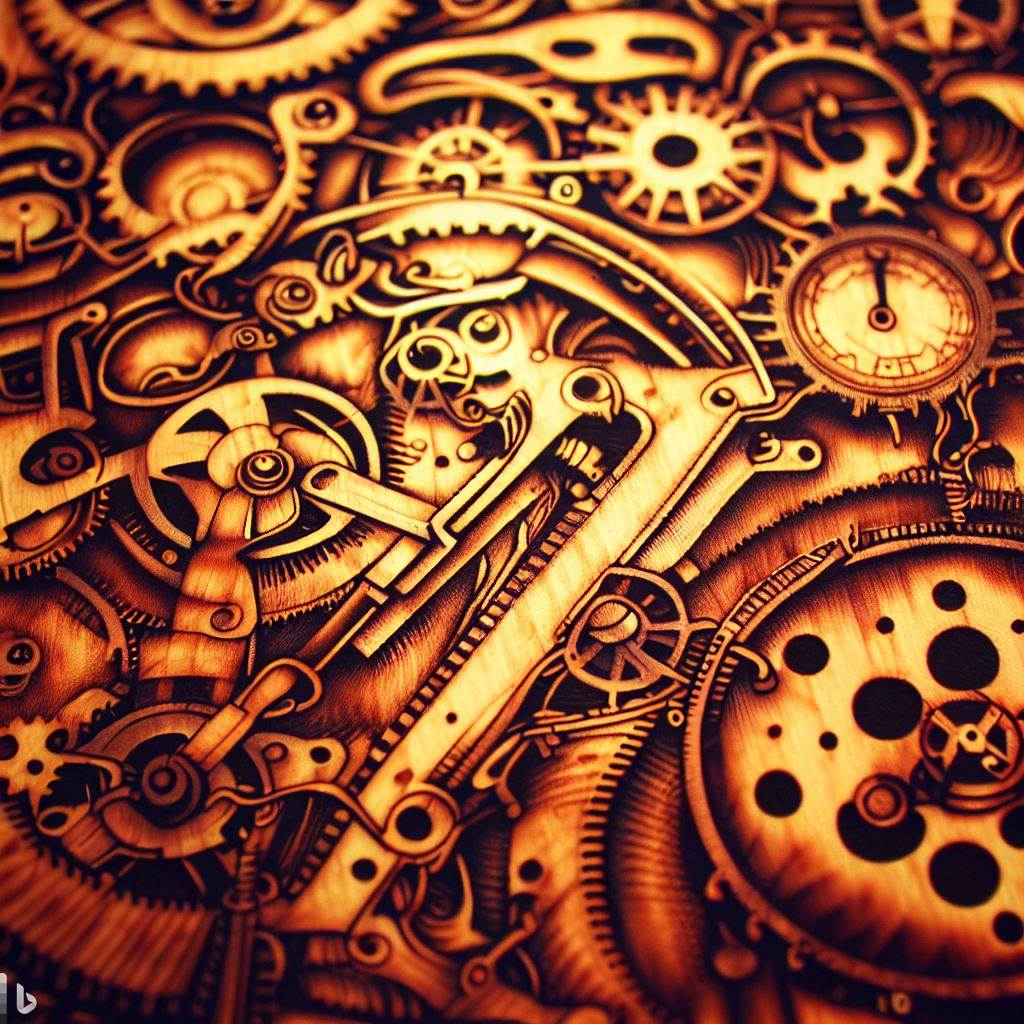Steampunk Pyrography: Blending Wood Burning with Steampunk Style and Aesthetics
The vintage industrial look of steampunk and the earthy warmth of pyrography make an artistically natural pairing. Blending these two mediums results in imaginative retro-futuristic pyrography perfect for decorating steampunk attire, props, furniture, and designs.
This guide covers tips for adapting traditional wood burning techniques to recreate popular steampunk visual elements. Learn how to tastefully burn cogs, gears, gauges, airships, timepieces and other embellishments right out of Victorian sci-fi onto wood. Full steam ahead into the world of steampunk pyrography!
Steampunk Influences and Themes
First, where does steampunk’s anachronistic mechanical style arise from?
Victorian Era Technology
Steam power machinery of the late 1800s inspires steampunk’s belching pipes, great gears, shuttles, presses, and contraptions. Antique equipment revamped.
Science Fiction and Fantasy
Sci-fi literature like Jules Verne transports steampunk into imaginative realms of time travel, mad scientists, fantastical engineering, and spacefaring adventure.
DIY Ethos
The handcrafted reuse of objects for inventive purposes echoes steampunk’s scrappy ingenuity. Old made new again through creativity.
Nostalgic Romanticism
Affection for travel by airship or rail and genteel fashion hearkens back to 19th century pioneering spirit and optimism in a modern cynic world.
This unique blend of science fiction and antique industrialism creates the quirky anachronistic aesthetic we know as steampunk. Now let’s explore translating that vintage vision into burned wood art.
Steampunk Style Elements for Pyrography
Here are some top steampunk-related subjects and decoration styles to incorporate into your wood burnings:
Cogs and Gears
The steampunk staple design. Burn all sizes of gears with various teeth along their circumference and pierce their centers with axles. Layer and connect them mechanically.
Pistons and Valves
Interpret pumping pistons, gauge needles, pressure valves, vacuum tubes, and elaborate plumbing merging into machinery. Mimic moving parts.
Airships and Goggles
What’s more steampunk than goggled aviators piloting zeppelins or prop planes? Recreate retro dirigibles and flying contraptions in dramatic scenes.
Keys and Watch Parts
Burn antique skeleton keys, clock faces, watch gears, springs, and assorted old timepieces with roman numerals and ornate casings. Overlap them like floating debris.
Telescopes and Binoculars
Long-lensed scientific optics imply exploration and discovery. Position them as if abandoned atop journal pages full of maps, charts, and scrawled equations.
Gadgetry and Instruments
Incorporate vintage-looking spectroscopes, switches, dials, coils, antennas, transmitters, and other fantastical instruments into your pyrogred contraptions and machines.
Text and Typography
Use flowing script, roman numerals, star maps, charts, diagrams and other ephemera to embellish scientific elements with the patina of history.
Techniques for Burning Dimensional Steampunk Elements
Mastering dimension creates realistic gears, airships, and objects. Useful techniques include:
Burn Layers
Dark detailed shadows come from gradually layering lighter base tones first, then re-burning over those to intensify values towards black. This avoids flatness.
Directional Hatching
Use diagonal hatching strokes in the direction where imagined light would naturally hit rounded surfaces. This generates realistic form and contours.
Stippling
Build up textures for weathered metal, wood grain, and leathery fabrics using loosely stippled dots that follow the material’s grain direction. Vary stipple patterns.
Imply Weight and Motion
Make heavy elements like gears and engines feel grounded using strong shadows and weight lines. Show pistons and propellers kinetically mid-motion.
Overlap Components
Layer and overlap individual components like cogs intermeshing rather than spacing items redundantly. This tight interconnectedness increases realism.
Perspective Lines
Use vanishing points and perspective techniques to render airships and machines receding realistically into space. This adds depth.
Composing Cohesive Steampunk Scenes
Thoughtful composition brings the steampunk elements together plausibly:
Unify with Backgrounds
Unify using backgrounds like wooden walls, weathered metal, star maps, journal pages, or blueprints overlaid behind gears and components to embed them into a setting.
Imply Narratives
Go beyond just random objects. Have gears turning a belt driving a pulley lifting an airship. Show processes and relationships that imply unfolding stories.
Select Key Focal Points
Highlight critical elements like faces, goggles, machinery functions, or dramatic moments as distinct areas of focus to carry the scene’s intention.
Balance Light and Dark
Aim for high contrast and rich shadows reminiscent of Rembrandt or Caravaggio paintings. This dramatic chiaroscuro lighting amplifies mood and emotion.
Incorporate Natural Elements
Accentuate the mechanical subjects with traces of vines, flowers, leaves, feathers, or crystals growing through. This contrasts and complements the steel and wood.
Use Scale Variety
Combine a mix of small and large scale gears, airships, components, etc. to create forced perspective illusion of depth. Big things seem farther away.
Inspiring Examples of Steampunk Pyrography
Seeing examples from talented pyrographers helps generate ideas:
- Eric Ross meticulously layers clocks, keys, gauges, and optics with precise realism.
- Sue Walters builds colorful characterful scenes with whimsical foxes piloting dirigibles.
- Valentina Dubyaskaya infuses traditional wood craft motifs like Khokhloma with steampunk flair.
- Daniel Engel embellishes jewelry boxes with custom steampunk latch mechanisms decorated through burning.
There are infinite possibilities for the imaginative retro-futurism of steampunk brought to life through pyrography’s fire. Let your creativity guide what unique way you merge and interpret these two decorative realms. The only limit is your vision’s scope!
